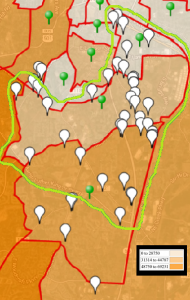The way the USDA defines food deserts — in terms of distance to a supermarket and income level at the unit of a census tract — can be portrayed easily from satellite views such as this map of a Food Desert in Southeast Durham, pictured by the USDA’s Food Desert Locator (here):
While these maps are visually compelling, there is a lot left to be desired in terms of understanding the situation on the ground within the community being labeled as a food desert. Nicholas School Alum, Sarah Parsons, problematized the USDA definition of Food Deserts and suggested qualitative metrics to better inform it in her 2012 Masters Project (see here). A whole suite of questions arise when you really attempt to disentangle the farm to fork process.
One question is relevant here.
Given the degree that churches are involved in the Durham community (in the larger context of the Bible belt), what degree are they involved in the food system at a neighborhood scale? Such ‘hyper-local’ questions are important to assess what is happening at the street view, especially considering the intimate nature of food in our lives.
I created this map of the same Southeast Durham Food Desert area as above. To create the map, I used a free online tool (GPS Visualizer), utilizing ‘KMZ Census Mapper’ median family income data (here) and church locations according to a 11/30/14 Google maps search.
I drew a green line around the census tracts which are identified as a food desert by the USDA’s Food Desert Locator (here).
Church locations are indicated by the white bubbles.
While this map may not tell us anything we did not already know on some level, it is apparent that churches are present throughout this ‘food desert’ area. The question of the church, food-hub responding to food desert seems relevant for further study.
Interestingly, a program exists which puts food and faith into practice through ‘Faith-Based Food Hubs’.
Cornell created a program called Farm to Faith in New York which has supported what they refer to as faith-based food hubs (see here). This is a powerful case study in the role that faith communities can play as food aggregators, marketers, and distributors.
I raise the question, would this model be applicable as a response to food deserts which also bolsters local food economies? Faith communities already engage in food relief; why not help create a sustainable food economy at the same time?
Is this already happening?
Former NFL center, Jason Brown, left football to start a farm which donates the “first fruits” of its produce to the hungry. His farm is aptly named ‘First Fruits Farm’ and is ~ 40 miles away from Durham, NC. Not only is this project heavily publicized, but it is produce heavy, donating 46,000 pounds of sweet potatoes in one weekend this last November (here).
Is there a future for a free, local-food economy operating through faith communities?
Can we dig up manna from the archeological record?




What an interesting post, thanks for sharing!
My appreciation, Shannon.